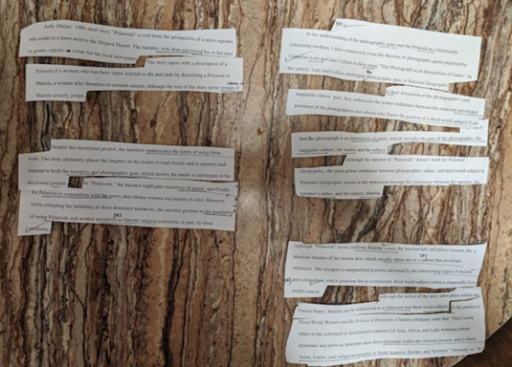Rocking a Paper with Scissors
By a UNC Undergraduate Student
It was late one night in December, and, with what seemed like hundreds of other people, I was in the library. I had been working on a paper about the U.S. intelligence community for weeks—reading articles, finding book chapters, and typing page after page of notes—and my head was spinning.
When I research a paper topic, I take lots of notes. I write out the title of an article (and usually the citation, too, so I don’t have to spend hours at the last minute tracking down authors and dates), and I make bullet points of the information and key quotes that I’ll need for my paper. This means that, when it comes time to write the actual paper, everything is sorted by source rather than by where it will fit in my argument. Sometimes I highlight bullet points in different colors to show where I want to put them, but this paper had to be at least fourteen pages long. Quite frankly, the idea of looking at every single color Google Docs had all at once made me a bit nauseous. By this time, my paper was due in less than twenty-four hours, and for the life of me I couldn’t see how these miles of bullet-point notes were going to come together into an essay I could turn in. Partly out of desperation, and partly out of feeling like I was going to put my foot through my computer screen if I stared at it any longer, I decided to print out my notes.

At a loss for what to do next and feeling a bit overwhelmed, I remembered a strategy I had heard people talking about at the Writing Center. I figured I had nothing to lose, so I decided to try it out. With a pair of scissors from the front desk, I began cutting up my stack of printed out notes. Sheet after sheet I cut into strips, with one piece of information on each strip. When I was done, I had a small mountain of paper on the desk in front of me.

After all this cutting, I got to work sorting. I started by creating several smaller piles, one for each section of my paper. Information about the structure of the intelligence community went into one pile, causes of intelligence failures into another, and the September 11 terrorist attacks into a third. For some notes, I couldn’t figure out anywhere to put them; reluctantly, I threw them aside. Once my mountain was broken down into a series of foothills, I examined each pile, arranging the strips of paper in the order I wanted to talk about them. Soon the entire table in front of me was covered; it felt a little bit like a scene out of A Beautiful Mind.

When I finished arranging the strips of paper on the table, I sat back in my chair and realized that I had just gone from a tangled mess of notes, facts, and quotes to an outline of my entire paper. All I had to do was reorganize my notes document, add some sentences to tie everything together, and proofread. Feeling a new burst of energy, I pulled my computer back out of my backpack and finished the paper in a couple hours.
Since that December night, I have only used the scissors strategy a couple of times. I have no doubt that printing out and cutting up my notes was the only reason I finished my U.S. intelligence community paper on time. But for shorter papers, I just haven’t found it necessary. Color coding my notes and making outlines the “normal” way has been sufficient for all but my longest essays (not to mention more eco-friendly). However, whenever I do come across a ten- or twelve-page research paper, and I start to feel like I have more notes and information than I could ever know what to do with, I know that I have a tool I can use. And with a senior honor’s thesis just over the horizon, I’m sure there will be plenty of strips of paper in my future!
This blog showcases the perspectives of UNC Chapel Hill community members learning and writing online. If you want to talk to a Writing and Learning Center coach about implementing strategies described in the blog, make an appointment with a writing coach or an academic coach today. Have an idea for a blog post about how you are learning and writing remotely? Contact us here.

